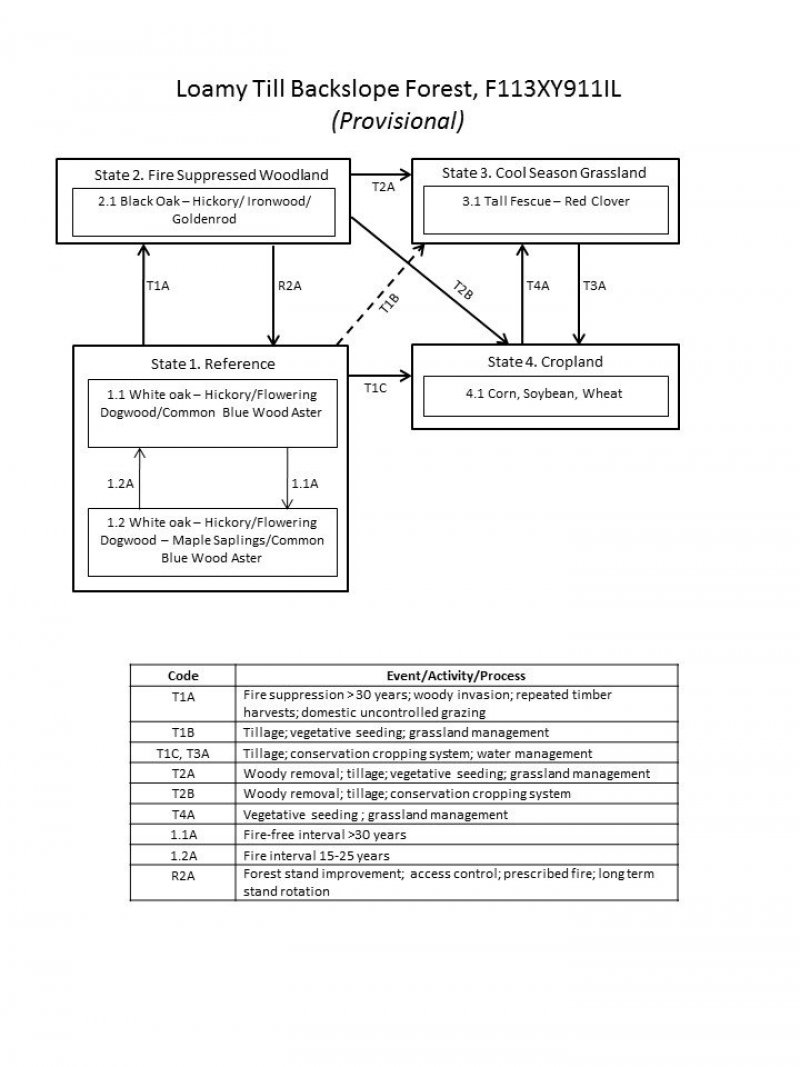
Natural Resources
Conservation Service
Ecological site F113XY911IL
Loamy Till Backslope Forest
Last updated: 5/17/2024
Accessed: 12/21/2025
General information
Provisional. A provisional ecological site description has undergone quality control and quality assurance review. It contains a working state and transition model and enough information to identify the ecological site.
MLRA notes
Major Land Resource Area (MLRA): 113X–Central Claypan Areas
The eastern Illinois portion of the Central Claypan Areas MLRA is in the Till Plains Section of the Central Lowland Province of the Interior Plains (USDA-NRCS, 2006) and includes the Southern Till Plain Natural Division of the natural divisions of Illinois (Schwegman, 1973; 1997; IDNR, 2018) in south-central Illinois. South-central Illinois is a dissected Illinoisan till plain south of the terminal Wisconsin moraine. This region consists of nearly level to gently sloping, old till plains. Stream valleys are shallow and generally are narrow. Elevation is about 660 feet (200 meters), increasing gradually from south to north. Local relief is generally low on the broad, flat till plains and flood plains and high on the dissected hills bordering rivers or drainage systems. The Kaskaskia, Little Muddy, Little Wabash, Embarras, and Skillet Fork rivers are part of this area. This region is covered with loess, which overlies old glacial drift (Illinoisan till) that has a high content of clay. Fragipans are also present. Pennsylvanian limestone and shale bedrock underlay the glacial till. The dominant soil orders in this region are Alfisol and Mollisol. The soils in the area predominantly have a mesic soil temperature regime, an aquic or udic soil moisture regime, and mixed or smectitic mineralogy. They generally are very deep, well drained to poorly drained, and loamy or clayey. (USDA-NRCS, 2006).
Classification relationships
Major Land Resource Area (MLRA) (USDA-NRCS, 2006):
113 – Central Claypan Areas, Eastern Part
U.S. Forest Service Ecoregions (Cleland et al. 2007):
Domain: Humid Temperate Domain
Division: Hot Continental Division
Province: Eastern Broadleaf Forest (Continental)
Province Code: 222
Section: Central Till Plains, Oak-Hickory Section
Section Code: 222G
Ecological site concept
The historic pre-European settlement vegetation or reference plant community was an oak-hickory forest with a shade-tolerant herbaceous understory. These communities were common throughout the Central Claypan Areas MLRA (Figure 1; green areas). Loamy Till Backslope Forest ecological sites occurred on convex, gently sloping to moderately steep slopes of dissected till plains on soils that formed in loess over glacial till. This reference ecological site had a somewhat closed tree canopy dominated by white oak (Quercus alba L.)*, shagbark hickory (Carya ovata (Mill.) K. Koch), mockernut hickory (Carya tomentosa (Lam.) Nutt.), and black oak (Quercus velutina L.), with an understory of flowering dogwood (Cornus florida L.), ironwood (Ostrya virginiana (Mill.) K. Koch) and blackhaw (Viburnum prunifolium L.) (White, 1978).
This ecological site was once widespread in the north-central United States. Stands occurred primarily on glaciated, rolling topography on a wide variety of soils that had a dry-mesic moisture condition. The canopy was variable but typically closed (>80%). White oak (northern red oak, Quercus rubra L., was present on protected slopes) was the leading dominant, but on exposed slopes black oak and shagbark hickory could also be codominant with white oak. Typical associates included mockernut hickory and pignut hickory (Carya glabra (Mill.) Sweet). The subcanopy contained ironwood, black cherry (Prunus serotina Ehrh.), sassafras (Sassafras albidum (Nutt.) Nees), and with cessation of disturbances, increasingly red maple (Acer rubrum L.) or sugar maple (Acer saccharum Marshall). The shrub layer was quite variable but could include flowering dogwood, stiff dogwood (Cornus foemina Mill.), and common pricklyash (Zanthoxylum americanum Mill.). The herbaceous layer could include American hogpeanut (Amphicarpaea bracteata (L.) Fernald), tall thimbleweed (Anemone virginiana L.), common blue wood aster (Symphyotrichum cordifolium (L.) G.L. Nesom), rattlesnake fern (Botrychium virginianum (L.) Sw.), pointedleaf ticktrefoil (Desmodium glutinosum (Muhl. ex Willd.) Alph. Wood), spotted geranium (Geranium maculatum L.), Clayton's sweet root (Osmorhiza claytonia (Michx.) C.B. Clarke), clustered blacksnakeroot (Sanicula odorata (Raf.) K.M. Pryer & L.R. Phillippe), and feathery false lily of the valley (Maianthemum racemosum (L.) Link). Disturbances such as fire, grazing and wind played a significant role in the maintenance of these systems. (NatureServe 2018).
* All plant common and scientific names in this document were obtained from the U.S. Department of Agriculture – Natural Resources Conservation Service National PLANTS Database (USDA NRCS, 2018).
Associated sites
| R113XY904IL |
Upland Prairie Prairie ecological sites are upslope but on dark colored soils associated with nearly level till plains. |
|---|---|
| F113XY907IL |
Fragic Till Plain Woodland Fragic Till Plain Woodlands have a fragipan and are on gentle slopes typically upslope. |
| F113XY919IL |
Wet Silty Floodplain Forest Wet Silty Floodplain Woodlands are downslope in valley floodplains. |
Similar sites
| F113XY913IL |
Clayey Till Backslope Woodland Clayey Till Backslope Woodland ecological sites also support an oak-hickory community, but poorer drainage results in a wetter environment that is less productive with more moisture tolerant species present. |
|---|
Table 1. Dominant plant species
| Tree |
(1) Quercus alba |
|---|---|
| Shrub |
(1) Cornus florida |
| Herbaceous |
(1) Symphyotrichum cordifolium |
Click on box and path labels to scroll to the respective text.
| T1A | - | Fire suppression > 30 years; woody invasion; repeated timber harvests; uncontrolled livestock grazing |
|---|---|---|
| T1B | - | Tillage; vegetative seeding; grassland management |
| T1C | - | Tillage; conservation cropping system; water management |
| R2A | - | Forest stand improvement; access control; prescribed fire; long term stand rotation |
| T2A | - | Woody removal; tillage; vegetative seeding; grassland management |
| T2B | - | Woody removal; tillage; conservation cropping system |
| T3A | - | Tillage; conservation cropping system; water management |
| T4A | - | Vegetative seeding ; grassland management |
State 1 submodel, plant communities
| 1.1A | - | Fire free interval greater than 30 years |
|---|---|---|
| 1.2A | - | Fire interval 15-25 years. |
